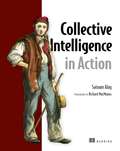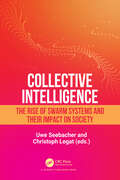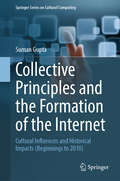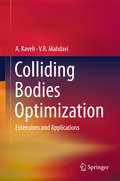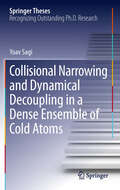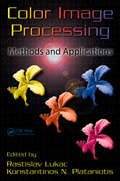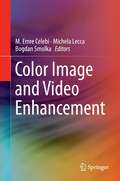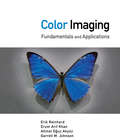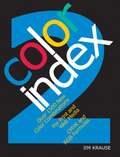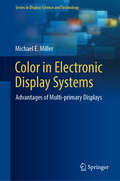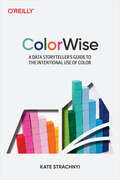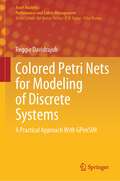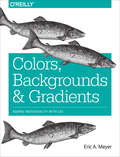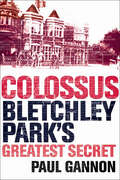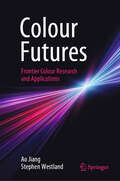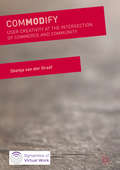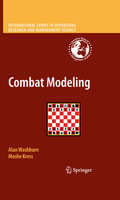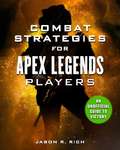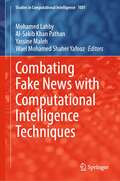- Table View
- List View
Collective Intelligence in Action
by Satnam AlagThere's a great deal of wisdom in a crowd, but how do you listen to a thousand people talking at once? Identifying the wants, needs, and knowledge of internet users can be like listening to a mob.In the Web 2.0 era, leveraging the collective power of user contributions, interactions, and feedback is the key to market dominance. A new category of powerful programming techniques lets you discover the patterns, inter-relationships, and individual profiles-the collective intelligence--locked in the data people leave behind as they surf websites, post blogs, and interact with other users.Collective Intelligence in Action is a hands-on guidebook for implementing collective intelligence concepts using Java. It is the first Java-based book to emphasize the underlying algorithms and technical implementation of vital data gathering and mining techniques like analyzing trends, discovering relationships, and making predictions. It provides a pragmatic approach to personalization by combining content-based analysis with collaborative approaches.This book is for Java developers implementing Collective Intelligence in real, high-use applications. Following a running example in which you harvest and use information from blogs, you learn to develop software that you can embed in your own applications. The code examples are immediately reusable and give the Java developer a working collective intelligence toolkit.Along the way, you work with, a number of APIs and open-source toolkits including text analysis and search using Lucene, web-crawling using Nutch, and applying machine learning algorithms using WEKA and the Java Data Mining (JDM) standard. Purchase of the print book comes with an offer of a free PDF, ePub, and Kindle eBook from Manning. Also available is all code from the book.
Collective Intelligence: The Rise of Swarm Systems and their Impact on Society
by Uwe Seebacher Christoph LegatUnlock the future of technology with this captivating exploration of swarm intelligence. Dive into the future of autonomous systems, enhanced by cutting-edge multi-agent systems and predictive research. Real-world examples illustrate how these algorithms drive intelligent, coordinated behavior in industries like manufacturing and energy. Discover the innovative Industrial-Disruption-Index (IDI), pioneered by Uwe Seebacher, which predicts industry disruptions using swarm intelligence. Case studies from media to digital imaging offer invaluable insights into the future of industrial life cycles.Ideal for AI enthusiasts and professionals, this book provides inspiring, actionable insights for the future. It redefines artificial intelligence, showcasing how predictive intelligence can revolutionize group coordination for more efficient and sustainable systems. A crucial chapter highlights the shift from the Green Deal to the Emerald Deal, showing how swarm intelligence addresses societal challenges.
Collective Principles and the Formation of the Internet: Cultural Influences and Historical Impacts (Beginnings to 2010) (Springer Series on Cultural Computing)
by Suman GuptaThis book describes how distinctive socio-political commitments and cultural practices developed upon the internet in the later 20th and early 21st century and considers what lies ahead in those terms. Five decades after the internet&’s technological structure began to be erected, and three decades after engagement with it started burgeoning, an active and global collective formation has grown upon it. This collective formation is dubbed the &‘Internet Polity&’ here and is distinguishable from, and yet embedded within, real-world collectives. Despite divergences and conflicts, its organization is based on certain shared principles and its culture characterized by distinctive discursive practices. This book examines how the Internet Polity developed until 2010, in terms of the technological and cultural features that have supported it. Accordingly, the Internet Polity&’s emerging prospects are considered. Topics and features: Gives an original framework for understanding the global collective grounded on the internet as a social space Presents a history of the technological basis and communication features of this collective, from the beginnings to 2010 Offers an interdisciplinary perspective that cuts across most disciplines of the humanities and social sciences Describes the histories of and debates surrounding popular terms like &‘cyberspace,&’ &‘information superhighway,&’ &‘Internet of Things,&’ &‘hacker,&’ etc. This wide-ranging and original book is for researchers, graduate students, professionals and informed readers who are interested in information technology and political culture, digital humanities, sociolinguistics and communication studies, history of the internet, contemporary social organization and political philosophy.
Colliding Bodies Optimization: Extensions and Applications
by A. Kaveh V. R. MahdaviThis book presents and applies a novel efficient meta-heuristic optimization algorithm called Colliding Bodies Optimization (CBO) for various optimization problems. The first part of the book introduces the concepts and methods involved, while the second is devoted to the applications. Though optimal design of structures is the main topic, two chapters on optimal analysis and applications in constructional management are also included. This algorithm is based on one-dimensional collisions between bodies, with each agent solution being considered as an object or body with mass. After a collision of two moving bodies with specified masses and velocities, these bodies again separate, with new velocities. This collision causes the agents to move toward better positions in the search space. The main algorithm (CBO) is internally parameter independent, setting it apart from previously developed meta-heuristics. This algorithm is enhanced (ECBO) for more efficient applications in the optimal design of structures. The algorithms are implemented in standard computer programming languages (MATLAB and C++) and two main codes are provided for ease of use.
Collisional Narrowing and Dynamical Decoupling in a Dense Ensemble of Cold Atoms (Springer Theses)
by Yoav SagiUltra-cold atomic ensembles have emerged in recent years as a powerful tool in many-body physics research, quantum information science and metrology. This thesis presents an experimental and theoretical study of the coherent properties of trapped atomic ensembles at high densities, which are essential to many of the aforementioned applications. The study focuses on how inter-particle interactions modify the ensemble coherence dynamics, and whether it is possible to extend the coherence time by means of external control. The thesis presents a theoretical model which explains the effect of elastic collision of the coherence dynamics and then reports on experiments which test this model successfully in the lab. Furthermore, the work includes the first implementation of dynamical decoupling with ultra-cold atomic ensembles. It is demonstrated experimentally that by using dynamical decoupling the coherence time can be extended 20-fold. This has a great potential to increase the usefulness of these ensembles for quantum computation.
Color Correction Handbook: Professional Techniques for Video and Cinema
by Alexis Van HurkmanThis is a comprehensive guide to color correction for film and video professionals covering every major color-correction software and hardware system. You will learn to apply the methods that all of the color correction applications use, how to problem-solve and trouble-shoot, how to maximize the effectiveness of each tool that's available, and you will discover how to creatively combine techniques and tools to accomplish the types of stylizations that colorists are often called upon to create.
Color Desktop Printer Technology
by Noboru Ohta Mitchell RosenPrinting traces its roots back for centuries, and the invention of moveable type changed the world. However, until the advent of the computer, printing remained a costly and time-consuming operation. From the first humble dot matrix to modern inkjet, laser, and dye sublimation printers, desktop printing has brought low-cost, high quality printing out of the large presses and into the home and office. Color Desktop Printer Technology provides an overview of the current state of the technology, examining both current and emerging applications.With expert contributors from leading companies and universities in the US and Japan, this book examines the color desktop printer from every angle. It begins with an introduction to the basic principles of color printing and the concepts of document and image quality. An overview of the historical background, current trends, and future directions places the technology in its business and market context. The book then devotes four chapters to the major platform: inkjet, laser printer, thermal transfer, and film recording. The last two chapters focus on color management and the quickly developing spectral printing technology.Laying a foundation for continued development and innovation in this ubiquitous field, Color Desktop Printer Technology is fundamental enough to be enjoyed by interested laypersons, yet detailed enough to satisfy the practicing engineer.
Color Image Processing: Methods and Applications (Image Processing Series)
by Rastislav Lukac Konstantios N. PlataniotisColor Image Processing: Methods and Applications embraces two decades of extraordinary growth in the technologies and applications for color image processing. The book offers comprehensive coverage of state-of-the-art systems, processing techniques, and emerging applications of digital color imaging. To elucidate the significant progress in specialized areas, the editors invited renowned authorities to address specific research challenges and recent trends in their area of expertise. The book begins by focusing on color fundamentals, including color management, gamut mapping, and color constancy. The remaining chapters detail the latest techniques and approaches to contemporary and traditional color image processing and analysis for a broad spectrum of sophisticated applications, including:Vector and semantic processingSecure imagingObject recognition and feature detectionFacial and retinal image analysisDigital camera image processingSpectral and superresolution imagingImage and video colorizationVirtual restoration of artworkVideo shot segmentation and surveillanceColor Image Processing: Methods and Applications is a versatile resource that can be used as a graduate textbook or as stand-alone reference for the design and the implementation of various image and video processing tasks for cutting-edge applications. This book is part of the Digital Imaging and Computer Vision series.
Color Image and Video Enhancement
by M. Emre Celebi Bogdan Smolka Michela LeccaThis text covers state-of-the-art color image and video enhancement techniques. The book examines the multivariate nature of color image/video data as it pertains to contrast enhancement, color correction (equalization, harmonization, normalization, balancing, constancy, etc. ), noise removal and smoothing. This book also discusses color and contrast enhancement in vision sensors and applications of image and video enhancement.
Color Imaging: Fundamentals and Applications
by Erik Reinhard Erum Arif Khan Ahmet Oguz Akyuz Garrett JohnsonThis book provides the reader with an understanding of what color is, where color comes from, and how color can be used correctly in many different applications. The authors first treat the physics of light and its interaction with matter at the atomic level, so that the origins of color can be appreciated. The intimate relationship between energy
Color Index 2: Over 1500 New Color Combinations For Print And Web Media CMYK And RGB Formulas
by Jim KrauseA new take on color combinations! Color Index 2 contains hundreds of different color combinations, each with an accurate formula for both print and web use. You'll easily find the best colors for your piece with chapters organized by dominant hue, and with unique expansion palettes--sets of four related hues arranged from dark to light--that allow you to explore even more color combinations for limitless possibilities. Designers, illustrators, photographers and fine artists alike will find this book an indispensable tool when it comes to finding color-related ideas and solutions. A companion to its best-selling predecessor, Color Index 2 offers even more colors and fresh new combinations of colors, making it easier than ever to create harmonious palettes for whatever project you're working on!
Color Management & Quality Output: Working with Color from Camera to Display to Print (The\digital Imaging Masters Ser.)
by Tom AsheFirst published in 2012. Focal Press is an imprint of the Taylor & Francis Group, an informa business.
Color Switch Juego en Línea La Guía No Oficial
by The Yuw Dafne Abad Romero*GUÍA NO OFICIAL* Además de la compra de este eBook siéntete libre de suscribirte a nuestro programa suplementario de guías gratis. Copiando el link que se encuentra más abajo, tendrás acceso a las últimas actualizaciones para los videojuegos más populares en línea. Suscríbete gratis aquí: http://emailsignupform.subscribemenow.com/ Guía de Consejos Avanzados y Estrategias. Es la guía más comprensible y detallada que encontrarás en línea. Disponible para descarga inmediata en tu teléfono móvil, dispositivo de eBook o en papel. Con el éxito de mis otros cientos de libros de guías y estrategias. He escrito otra guía avanzada profesional para jugadores nuevos y veteranos, la cual contiene estrategias específicas y consejos de cómo progresar en el juego, vencer a tus oponentes, adquirir más monedas, ! y mucho más¡ Aquí está lo que obtendrás al comprar esta detallada guía avanzada y profesional. - Consejos Profesionales y Estrategias. - Trucos y Hacks. - Secretos, Consejos, Trucos, Desbloqueos y !Trucos Usados Por Jugadores Profesionales! - Cómo conseguir toneladas de Monedas. - !Y MUCHO MÁS! Todas las versiones de ésta guía tienen capturas de pantalla para ayudarte a entender mejor el juego. No existe otra guía que sea tan avanzada y comprensible como esta. Estarás feliz de haber comprado ésta guía ya que te beneficiarás mucho de ella comparado con las otras guías menos efectivas que encontrarás. !Compra ahora y derrota a tus oponentes! !Conviértete en un jugador Profesional Hoy! Para soporte y más información de nuestros productos por favor visita el sitio: http://www.hiddenstuffentertainment.com/ Declaración: Este producto no está asociado, afiliado, avalado o patrocinado por el dueño original de los derechos de autor, ni están revisados, probados o certificados..
Color in Electronic Display Systems
by Michael E. MillerThis book explores the principles, design, and image processing of multi-primary displays, and introduces the reader to the intricacies of the typical imaging pathways which influence display design and the perception of color within a display system. Early chapters introduce the concepts behind human perception, color science, and lighting, which are necessary to fully understand multi-primary displays. The reader is also introduced to digital capture and transmission systems to better understand the ecosystem in which multi-primary displays exist. Subsequent chapters introduce the reader to current display technologies, including LCD, OLED, and inorganic LED displays. The working principles, performance, and upcoming advances are discussed for each of these technologies to provide the reader with a clear understanding of the tradeoffs which are necessary when considering multi-primary displays. This discussion is followed by an in-depth discussion of the image processing technology necessary to implement multi-primary displays. The book concludes with chapters that clearly discuss the advantages and limitations of multi-primary displays for direct view, virtual reality, and augmented reality displays. The book provides a broad viewpoint across the entire display ecosystem, explaining the interactions among system components to provide a rationale for the further development of multi-primary displays. Whether the reader is interested in broadening their understanding of display systems or the development of multi-primary displays, the text provides and understandable and practical summary of important display system concepts.
ColorWise: A Data Storyteller's Guide to the Intentional Use of Color
by Kate StrachnyiData has become the most powerful tool in business today, and telling its story effectively is critical. Yet one of the best communicators—color—is the most neglected tool in data visualization. With this book, DATAcated founder Kate Strachnyi provides the ultimate guide to the correct use of color for representing data in graphs, charts, tables, and infographics.Ideal for data and business analysts, data scientists, and others who design infographics and data visualizations, this practical resource explores color tips and tricks, including the theories behind them and why they work the way they do. ColorWise covers the psychology, history, and culture of many different colors. This book is also a useful teaching tool for learning about proper use of color for data storytelling techniques and dashboarding.You'll explore:The role that color theory plays in data visualization and storytellingVarious color techniques you can use to improve data visualizationsHow colors affect your audience's understanding of data visualizationsHow to use color intentionally to help guide your audienceTips for using colors that people with color vision deficiency can interpretHow to apply the book's guidelines for use in your own projects
Colored Petri Nets for Modeling of Discrete Systems: A Practical Approach With GPenSIM (Asset Analytics)
by Reggie DavidrajuhThis book offers a practical approach to modeling real-world discrete systems and performing analysis. The theory behind the book is the Colored Petri nets, and the tool used for simulations is general-purpose Petri net simulator (GPenSIM). The theory part is kept to a minimum, and more explanation is given to the GPenSIM functions and how they can be used for modeling, simulation, and performance analysis. Real-world industrial systems possess a large number of resources. Modeling these systems with Petri nets would become a problem as they result in huge Petri net models. This book offers a unique solution to this problem by moving resources away from the Petri net model and treating them as variables in the background. Also, the theory and practice put forward in the book help cost estimation of the systems (e.g., manufacturing subsystems).
Colors, Backgrounds, and Gradients: Adding Individuality with CSS
by Eric A. MeyerOne advantage of using CSS3 is that you can apply colors and backgrounds to any element in a web document, create your own gradients, and even apply multiple backgrounds to the same element. This practical guide shows you many ways to use colors, backgrounds, and gradients to achieve some pretty awesome effects.Short and sweet, this book is an excerpt from the upcoming fourth edition of CSS: The Definitive Guide. When you purchase either the print or the ebook edition of Colors, Backgrounds, and Gradients, you’ll receive a discount on the entire Definitive Guide once it’s released. Why wait? Learn how to bring life to your web pages now.Define foreground colors for a border or element with the color propertyCombine foreground and background colors to create interesting effectsPosition and repeat one or more images in an element’s backgroundFix an image to a screen’s viewing area, rather than to the element that contains itUse color stops to define vertical, horizontal, and diagonal linear gradientsCreate spotlight effects, circular shadows, and other effects with radial gradients
Colossus: Bletchley Park's Greatest Secret
by Paul GannonIn 1940, almost a year after the outbreak of World War II, Allied radio operators at an interception station in South London began picking up messages in a strange new code. Using science, math, innovation, and improvisation, Bletchley Park code breakers worked furiously to invent a machine to decipher what turned out to be the secrets of Nazi high command. It was called Colossus. What these code breakers didn't realize was that they had fashioned the world's first true computer. When the war ended, this incredible invention was dismantled and hidden away for almost 50 years. Paul Gannon has pieced together the tremendous story of what is now recognized as the greatest secret of Bletchley Park.
Colour Futures: Frontier Colour Research and Applications (Vision, Illusion and Perception #5)
by Stephen Westland Ao JiangThis book delves into the nuanced interplay of colour in human perception and its applications across diverse fields, highlighting the transformative impact on art, design, digital media, and technology. The book introduces an innovative approach by integrating scientific research with practical applications, making it a pivotal resource for designers, psychologists, and technologists. Its scope ranges from foundational aspects of colour vision to futuristic applications in virtual reality and artificial intelligence, offering fresh insights and forecasting emerging trends. This comprehensive exploration is essential for anyone interested in the strategic use of colour to enhance user experience and cultural expressions.
Colour for Web Design: Apply Colour Confidently and Create Successful Websites
by Cameron ChapmanColour is one of the most powerful tools at a designer's disposal, yet few truly understand how much it can do for them, and the immediate difference it will make to the popularity and success of their website.This is the complete guide to creating a unique, practical and appropriate colour palette for any web design project. Building on the basics, starting with essential - often misunderstood - terminology and an understanding of traditional colour palettes, the book then moves on to practical, real-world examples of sites with fantastic colour schemes.A one-stop shop for a complete knowledge of digital colour, this book will give the designer the confidence to create their own palettes and apply colour successfully to their designs.
ComMODify: User Creativity at the Intersection of Commerce and Community (Dynamics of Virtual Work)
by Shenja van der GraafThis book critically analyses user-firm technology relationships and socioeconomic structures at the crossroads of community and commerce. It investigates businesses that let users participate in platform development on the internet. An empirical study of the online world Second Life is used as an early illustration of the pivotal role of user participation in design, development and sustainability of digital platforms. Van der Graaf sheds light on aspects of the ongoing platformization of the internet and on new norms and mechanisms for user participation which are linked to values of creativity, community and labour. ComMODify makes clear that robust theoretical and empirical investigation of the integration of user participation into mainstream business models and its implications for platform development is key to understanding contemporary businesses like Facebook, that sustain the internet of today. This book will be of interest to those wanting to learn more about the socio-economic implications of user participation associated with user-generated content, particularly within the 3D software and game industry.
Combat Modeling (International Series in Operations Research & Management Science #134)
by Alan Washburn Moshe Kress"Combat Modeling" is a systematic learning resource and reference text for the quantitative analysis of combat. After a brief overview, authors Washburn and Kress present individual chapters on shooting without feedback; shooting with feedback; target defense; attrition models; game theory and wargames; search; unmanned aerial vehicles; and terror and insurgency. Three appendices provide a review of basic probability concepts, probability distributions, and Markov models; an introduction to optimization models; and a discussion of Monte-Carlo simulations. Drawing on their many years of experience at the Naval Postgraduate School in Monterey, California, Washburn and Kress have created a reference that will provide the tools and techniques for analysts involved in the underpinnings of combat decisions. This is a book that can be used as a military manual, reference book, and textbook for military courses on this vital subject.
Combat Strategies for Apex Legends Players: An Unofficial Guide to Victory
by Jason R. RichThe Tell-All, Essential Guide for the Hottest Game of 2019!Combat Strategies for Apex Legends Players is a full-color, information-packed strategy guide designed to quickly get newbs (beginners) acquainted with the many intricacies of the game, while teaching more advanced and proven exploration, survival, and combat strategies to experienced gamers looking to improve their kill-rate, familiarity with weapons, and survival skills.Combat Strategies for Apex Legends Players offers an easy-to-read format that showcases hundreds of full-color screenshots from the PC, Xbox One, and PS4 versions of the game to help you master EA’s Apex Legends and get the most out of your gameplay experience. Each section of this vital handbook focuses on one important element or aspect of the game, allowing you to make intelligent decisions when: Choosing your LegendBuilding an arsenalWorking with squad matesExploring Kings Canyon,Fighting and consistently winning matchesAnd more! Get the scoop early and beat the competition for Apex Legends with the indispensable knowledge you gain from Combat Strategies for Apex Legends Players!
Combating Crime on the Dark Web: Learn how to access the dark web safely and not fall victim to cybercrime
by Nearchos NearchouKnow your enemy and counter the dark web criminality with this easy-to-follow guide, including a detailed tour of the dark web ecosystem and the tools and tactics used to mitigate cyber threatsKey FeaturesGet up to speed with the ins and outs of cybercriminal activity on the dark webBecome familiar with the tools and techniques that are used to fight serious crimeGain a keen understanding of the crime ecosystem on the dark web and the best practices to keep it in checkBook DescriptionIn today's world, the crime-prevention landscape is impossible to navigate. The dark web means new frontiers of combat against bad actors that pop up daily. Everyone from narcotics dealers to human traffickers are exploiting the dark web to evade authorities. If you want to find your feet in this tricky terrain and fight crime on the dark web, take this comprehensive, easy-to-follow cyber security guide with you.Combating Crime on the Dark Web contains everything you need to be aware of when tackling the world of the dark web. Step by step, you'll gain acumen in the tactics that cybercriminals are adopting and be equipped with the arsenal of strategies that are available to you as a cybersecurity specialist.This cyber security book ensures that you are well acquainted with all the latest techniques to combat dark web criminality. After a primer on cybercrime and the history of the dark web, you'll dive right into the main domains of the dark web ecosystem, reaching a working understanding of how drug markets, child pornography, and human trafficking operate. Once well-versed with the functioning of criminal groups, you'll be briefed on the most effective tools and methods being employed by law enforcement, tech companies, and others to combat such crimes, developing both a toolkit and a mindset that can help you stay safe from such criminal activities and can be applied in any sector or domain. By the end of this book, you'll be well prepared to begin your pushback against the criminal elements of the dark web.What you will learnUnderstand the history of cybercrime, the dark web, and the use of TorDiscover the ecosystem of dark web drug marketsBecome familiar with the methods law enforcement use to stop child abusersDive deep into real-life human trafficking cases and how they were tackledExplore sting operations, honeypots, and cybercrime prevention methodologiesGain expertise in Pipl Search, MEMEX, BITCRIME, and other anti-crime toolsInvestigate open-source intelligence and intelligence-led policingSet up a framework for disrupting organized crime on the dark webWho this book is forThis book is for aspiring cybercrime investigators, cybersecurity enthusiasts, and anyone else who is interested in learning about this dark side of the internet. The book mainly focuses on preventing crimes on the dark web and is written in a simple way so that you can understand it with ease.
Combating Fake News with Computational Intelligence Techniques (Studies in Computational Intelligence #1001)
by Al-Sakib Khan Pathan Yassine Maleh Mohamed Lahby Wael Mohamed Shaher YafoozThis book presents the latest cutting-edge research, theoretical methods, and novel applications in the field of computational intelligence techniques and methods for combating fake news. Fake news is everywhere. Despite the efforts of major social network players such as Facebook and Twitter to fight disinformation, miracle cures and conspiracy theories continue to rain down on the net. Artificial intelligence can be a bulwark against the diversity of fake news on the Internet and social networks. This book discusses new models, practical solutions, and technological advances related to detecting and analyzing fake news based on computational intelligence models and techniques, to help decision-makers, managers, professionals, and researchers design new paradigms considering the unique opportunities associated with computational intelligence techniques. Further, the book helps readers understand computational intelligence techniques combating fake news in a systematic and straightforward way.
